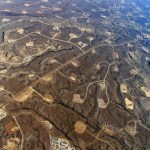groundwater
Research makes it increasingly clear that along with drilling for oil and mining coal, extracting natural gas from deep underground causes serious damage to the environment and to public health. On The Pump Handle, Kim Krisberg examines the contamination that may result from dumping fracking wastewater into disposal wells, writing "about 1,000 different chemicals are used in the fracking industry, with more than 100 being known or suspected endocrine disruptors." Researchers collected water samples downstream from wells in West Virginia, and after "exposing both female and male mammalian sex…
By Peter Gleick, Brett Walton, J. Carl Ganter
Water was a Top Risk on the 2015 Global Agenda
In early 2015, participants at the World Economic Forum, a who’s who of the political and business elite, ranked water crises as the top global risk. Water was also a key factor in the adoption by the United Nations General Assembly of the Sustainable Development Goals (SDGs), a blueprint for international development over the next 15 years. Ensuring safe drinking water and sanitation for all by 2030 is one of six water goals for the SDGs. In December at the UN climate change conference in Paris,…
(Photo: Peter Gleick 2008)
The recent severe drought in the Western United States -- and California in particular -- has shined a spotlight on a range of water-management practices that are outdated, unsustainable, or inappropriate for a modern 21st century water system. Unless these bad practices are fixed, no amount of rain will be enough to set things right. Just as bad, talking about many of these bad practices has been taboo for fear of igniting even more water conflict, but the risks of water conflicts here and around the world are already on the rise and no strategy that can reduce…
Heather Cooley, Kristina Donnelly, Peter Gleick
Last week, the Pacific Institute published the first comprehensive analysis of the impacts of the drought on California crop revenue and agricultural employment through 2014. The study showed that during the recent drought California’s agriculture sector experienced record-high crop revenue and employment. Crop revenue peaked in 2013 at $33.8 billion, the highest level in California history, and declined only slightly to $33.4 billion in 2014 (all economic data have been corrected for inflation). Statewide agriculture-related jobs also reached a…
Heather Cooley and Peter Gleick
California is in a severe drought – four years long now. But what does the drought really mean for the things we care about: food production, fisheries, industrial activities, rural communities? As part of the work of the Pacific Institute to evaluate both the impacts of water problems and identify smart solutions, we’ve just released the first comprehensive assessment of the actual impacts of the drought for California agriculture.
Many commentators and analysts have worried especially about California’s agricultural sector, which is a major water user and has…
The California drought continues.
While we do not know yet what the rest of the wet season will bring – and while we hope for the major storms needed to recharge our rivers, groundwater and reservoirs – it seems increasingly likely that California will not see enough precipitation to get out of the very deep deficit that three years of drought (so far) have produced.
There is, however, some misleading and confusing information out there. Some are already arguing that California’s rainfall is nearly back to normal or that because there may have been more serious droughts in the past we needn’t…
In a new study just published by the journal Sustainability Science (Springer), analysis from the Pacific Institute (with lead author Dr. Juliet Christian-Smith, now at the Union of Concerned Scientists) shows that many of the fundamental responses of California water users to severe drought actually make the state’s overall water conditions worse – that in the end, many of these actions are “maladaptations.”
Water is a complex resource; and water problems are an equally complex mix of natural resource, technology, social, economic, and political conditions. When water is limited,…
In the past few weeks, I have had been asked the same question by reporters, friends, strangers, and even a colleague who posts regularly on this very ScienceBlogs site (the prolific and thoughtful Greg Laden): why, if the California drought is so bad, has the response been so tepid?
There is no single answer to this question (and of course, it presumes (1) that the drought is bad; and (2) the response has been tepid). In many ways, the response is as complicated as California’s water system itself, with widely and wildly diverse sources of water, uses of water, prices and water rights,…
We’ve entered a new era: politicians can now talk loud and clear about the reality of human-induced climate change and the growing threats to humanity. With strong, unambiguous statements by President Barack Obama, Secretary of State John Kerry, Senator Sheldon Whitehouse, and a growing chorus of other top-level voices, the wholesale denial of climate science is increasingly relegated to a tiny group of industry-funded voices and their followers (directly mirroring the tobacco story decades ago); confused or ignorant politicians; and those who hope to avoid the difficult policy discussions by…
Droughts – especially severe droughts – are terribly damaging events. The human and ecosystem costs can be enormous, as we may relearn during the current California drought.
But they are also opportunities – a chance to put in place new, innovative water policies that are not discussed or implemented during wet or normal years.
In the hopes that California’s warring water warriors open their minds to policy reform, here are some of the issues that should be on the table now, in what could be the worst drought in California’s modern history. But here is what I fear, said best by John Steinbeck…
Dropping water levels in Lake Mead, behind Hoover Dam. (Source: Peter Gleick 2013)
It is no surprise, of course, that the western United States is dry. The entire history of the West can be told (and has been, in great books like Cadillac Desert [Reisner] and Rivers of Empire [Worster] and The Great Thirst [Hundley]) in large part through the story of the hydrology of the West, the role of the federal and state governments in developing water infrastructure, the evidence of droughts and floods on the land, and the politics of water allocations and use.
But the story of water in the…
For some time now, proponents of the controversial practice of hydraulic fracturing or “fracking” have claimed there was little or no evidence of real risk to groundwater. But as the classic saying goes: “the absence of evidence is not evidence of absence” of a problem. And the evidence that fracking can contaminate groundwater and drinking water wells is growing stronger with every new study.
As most people now know, fracking is a method for enhancing the production of natural gas (or oil, or geothermal energy wells). Fracking involves injecting fluids -- typically complex mixes of water and…
During the 1970s, international aid agencies came up with a brilliant plan to stem a plague of water-borne illnesses in the Asian country of Bangladesh. They would underwrite the installation of wells in disease-troubled villages, tapping into the cleaner ground water below.
They would use simple, relatively inexpensive tube wells, place thousands of these over-sized drinking straws into the shallow aquifers. And these straws - millions of them - would suck up the cleaner, microorganism free water in healthy abundance.
At first, it seemed to work like a blessing. Infant mortality…

